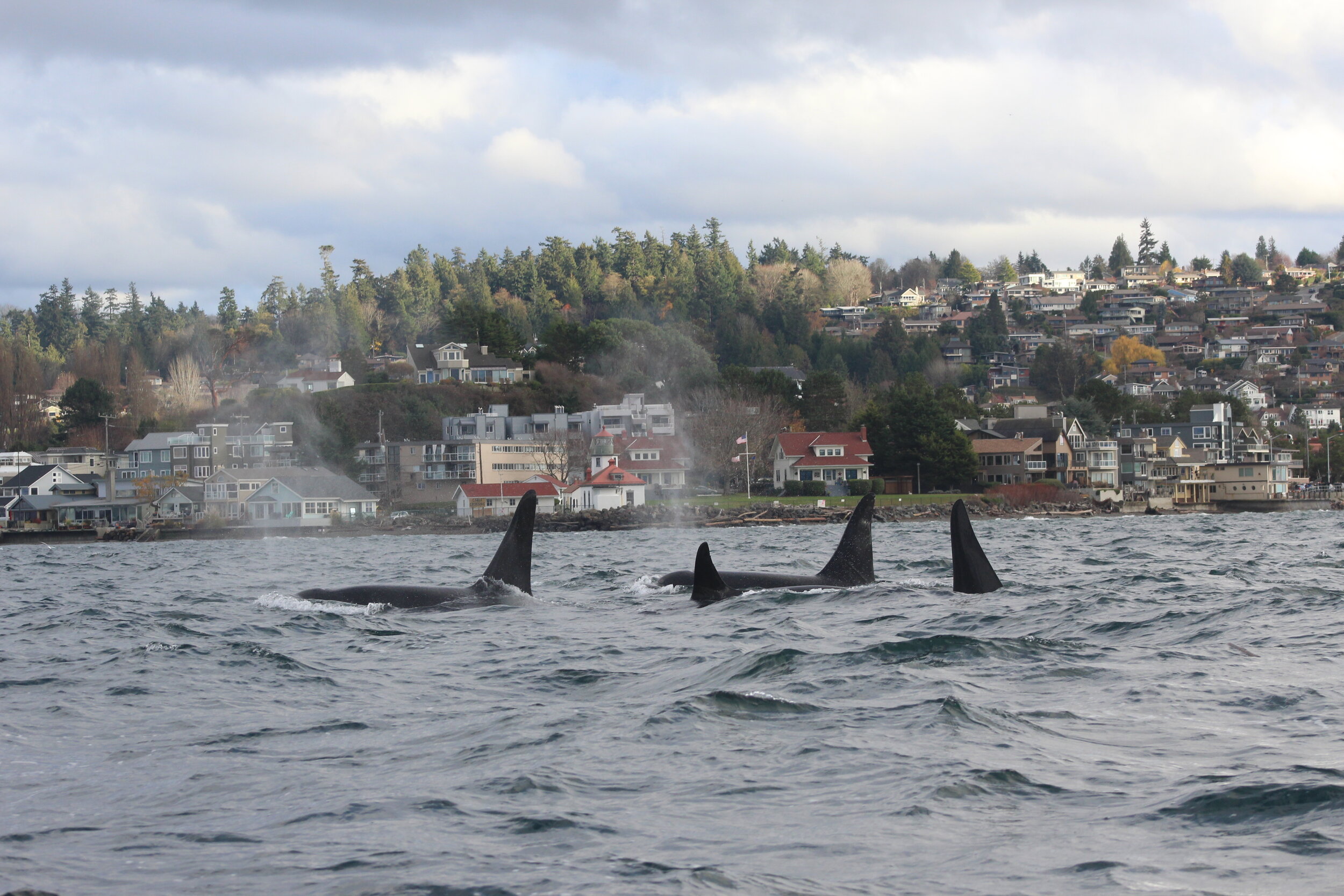
Frequently Asked Questions
JUMP TO CATEGORY:
About the Pledge
Why is this pledge necessary?
The southern resident orcas (J, K and L pods) are critically endangered. From a high of 98 animals in 1996, the population declined year after year, to its current near-historical low of 74 individuals. If this growth rate worsens or continues, the population could go extinct in less than 100 years (WDFW 2004).
The threats faced by the orcas are all human-caused: lack of salmon, toxic accumulations, and stress and noise from boats. These are interrelated, each worsening the other.
Orca are acoustic animals and use echolocation to find and hunt their prey. Vessel noise and disturbance makes it harder for them to find food, which makes them stressed and hungry, and more susceptible to disease.
Recent NOAA studies showed that female southern resident orcas stop foraging when vessels approach closer than 400 yards, and that all are less successful at catching prey when vessels approach closer than 1,000 yards. (Holt et al, Vessels and their sounds reduce prey capture effort by endangered killer whales (Orcinus orca), Marine Environmental Research 170: art. 105429 (2021).
There are 9 new calves and five years old in the population, and six of those are female. The future of the population is here. Their ability to survive and thrive into adulthood depends on the actions we take today. Boaters have a key role to play.
We envision a brighter future when the orcas are recovered, thriving in healthy and abundant seas. But that day will never come unless we act boldly to protect them now.
The whales are already protected by federal and state law. Isn’t that enough?
In 2023, Washington State passed a law establishing a 1,000-yard buffer around the southern residents for all boaters. The recommendation is based on best available science, the continuing decline of the population, and the need to harmonize existing rules. The law takes effect on January 1 2025. There’s no reason to wait to give the whales the space they need!
Washington State currently requires boaters to stay 300 yards away from southern residents. Commercial operators are required to stay 1,000 yards away October through June, and are allowed to get as close as 300 yards July through September, for two 2-hr periods each day.
U.S. Federal law requires that boaters stay 200 yards away from southern residents.
Canadian interim management measures require all boaters to stay 400 km away from all orcas.
The Be Whale Wise guidelines should be followed as an absolute minimum.
New calf J58 and family (Mark Sears, permit #21348)
Threats to Orcas
Why are the orcas endangered?
Decades of studies show that the threats faced by the orcas are all human-caused: lack of salmon, toxic accumulations, and stress and noise from boats. These work like a three-legged stool, each impacting the other:
Orcas are the top predator in the sea. Toxins like PCBs and other harmful chemicals bioaccumulate in orcas, adhering to lipids (fat cells) and stored in blubber and mother’s milk. When orcas are stressed and hungry, toxins are released into their bloodstream, making them more susceptible to disease. Vessel noise and disturbance makes it harder for them to find and catch their prey, which makes them stressed and hungry...and so it goes.
Isn’t the problem that the orcas need more salmon?
To recover the orcas we need to address all three threats. We need to increase salmon abundance, reduce toxins, and decrease noise and disturbance from vessels. Not one of these things, but all. The more Chinook salmon there is, the better! But the whales have to be able to find it. Reducing boat noise makes it easier for the orcas to hunt their prey—and is even more important when salmon are scarce.
Why don’t the orcas just switch to eating seals?
Though orcas are the top predator in the sea, what they eat, and how they hunt, is cultural—taught to them by their families. Southern resident orcas are highly specialized fish-eaters.
Orcas also appear to be conservative. There’s no evidence that southern residents - or any orcas -would make large-scale cultural changes (where they live or what they eat) even to survive.
How is noise related to foraging?
Multiple studies show that noise and salmon availability are inextricably linked. Orcas are acoustic animals. They use echolocation to find and hunt their prey, and a complex system of calls to communicate with each other.
It’s estimated that in a quiet sea, orcas can echolocate on a salmon 650 yards away. Any noise within that range effectively shrinks the orcas’ world, limiting their access to prey - and each other.
Vessel noise masks echolocation clicks, effectively blinding the orcas to the prey they seek. Tollit et al estimate the orcas lose 5.5 hours of foraging time each day due to noise and disturbance from commercial traffic and whale-watching vessels.
Orcas share their prey with each other, in ways that researchers are just beginning to understand. DFO research shows that mothers share prey with their offspring, and older sons share with their mothers. (Wright et al 2016). Giving the whales more acoustic space makes it easier for them to communicate with each other, too.
Is noise the same thing as disturbance?
No. Motorized and non-motorized vessels like kayaks can disturb orcas simply by their presence. Studies show that physical disturbance alone can change orcas’ behavior, cost them energy, and disrupt foraging. Disturbance may also change the behavior of prey that the orcas are trying to catch.
It can take an orca 15 minutes to catch a salmon. Any disturbance to the orcas or the fish they are chasing can impact the hunt, and change its outcome.
Is there an alternative to boat-based whale-watching?
Yes! The Salish Sea is ringed with locations where you can see other orcas and marine mammals from shore. Southern residents are most reliably seen June through September in the San Juan and Gulf Islands, and October through January in lower Puget Sound, from Port Townsend to Point Defiance, including near Seattle. Visit The Whale Trail to find viewing locations around the Salish Sea and along the Pacific Coast.
Is whale-watching of the southern residents allowed in Canada?
No. The Canadian government has implemented management measures to protect the southern residents, including fisheries closures, establishment of feeding sanctuaries, and a suspension on watching southern residents by all vessels. Recreational and commercial vessels are required to stay 400 meters away from all orcas in the Salish Sea and around the southern end of Vancouver. The suspension has been in place since 2019.
Learn more at the DFO website: 2020 Management Measures to Protect Southern Resident Killer Whales
Recreational Vessel Impacts
How do recreational boaters impact the orcas?
Noise and disturbance from recreational boats also interferes with orcas’ foraging and communication—whether the boats are actively whale-watching or transiting through an area. There is also a serious risk of strikes and direct harm to the orcas when any kind of boat, from motorboats to jet-skis, approaches too close.
Despite the potential of encountering southern residents, Soundwatch data show that only 50% of the recreational boaters approached in 2021 were aware of the Be Whale Wise guidelines and relevant laws.
All boaters should familiarize themselves with the regulations, keep an eye out for whales and for boats flying the Whale Warning Flag, and consider taking this pledge.
What about kayaks and paddleboards—do they impact the orcas?
Yes. Studies show that physical disturbance alone, even from kayaks and other boats with no engine running, can change orcas’ behavior, cost them energy, and disrupt foraging.
Boats of all types, including paddle-boards and kayaks, are required by law to follow the Be Whale Wise guidelines at a minimum.
Commercial Whale-Watching Impacts
Does the pledge require whale-watching companies to stop all whale-watching?
No. Whale-watching companies can continue watching all other species. The pledge applies only to southern residents, which comprise less than 10% of commercial whale-watching viewing opportunities.
Didn’t the state just adopt new rules for commercial whale-watching?
Yes, Washington State recently implemented a licensing program for commercial whale-watching businesses, which includes rules to protect the southern residents. The rules require commercial operators to stay 1,000 yards away from southern residents October through June, and allows limited whale watching at closer distances July through September. We encourage commercial operators to stay 1,000 yards away year-round.
Will this have an economic impact on the whale-watching companies? Don’t they need to keep watching southern residents to stay in business?
No. A recent report found that commercial whale-watching companies do not depend on watching southern residents for economic viability.
Over the past decade, while the southern residents declined, the number of commercial vessels more than doubled, and their revenue nearly tripled. The industry has thrived despite fewer and fewer opportunities to view southern residents.
In fact, avoiding southern residents appears to be better for business. The same report found that while a voluntary suspension on watching southern residents was in place in Canada in 2019, ridership on commercial vessels increased by 7.6%. Passengers want to support businesses that are going the extra mile to protect the Southern Residents.
We support a thriving, sustainable commercial whale-watching industry that contributes to the local economy, educates the public and inspires conservation. There is no economic need for commercial operators to get close to the southern residents, and there is a conservation imperative to give the whales the space they need to forage, rest, and rear their young.
As the only industry that approaches southern residents intentionally, commercial whale-watching companies have a powerful role to play in orca recovery. By choosing to avoid the southern residents, they can both reduce their direct impact, and set a positive example for recreational boaters who follow their lead. Commercial operators near Tofino have voluntarily stopped watching southern residents since 2019.
Large Vessels
Are large ships like ferries and tankers a problem too?
Yes. Large vessels like container ships, tankers, and ferries also contribute to the noise and disturbance around the orcas. The deployment of sonar and other military exercises puts orcas and all marine mammals at risk. The risk of oil spills is a huge threat, especially within the narrow reaches in the Salish Sea. One large oil spill could wipe out the population.
Many maritime industries and agencies are working together to reduce harmful impacts to the orcas. For example, commercial shipping companies participated in a voluntary slowdown in Haro Strait under the direction of Port of Vancouver’s ECHO program. The Quiet Sound initiative recently launched in Washington State and will implement voluntary shipping noise-reduction initiatives and monitoring programs in Puget Sound.
About Orcas
Orcas are the top predator in the sea. They are one of the most widely distributed marine mammals, present in every ocean and both poles. What they eat and how they hunt is cultural, taught to them by their families. Some orcas eat marine mammals such as seals, porpoises, or other whales. Others eat fish, such as sharks, or cod, or salmon.
Three kinds, or ecotypes of orcas live in the northeast Pacific, differentiated by diet, family structure, range and morphology.
Bigg’s (transient) orcas eat marine mammals, and live in small family groups usually consisting of a mother and her offspring. They range is wider, and there travel patterns less predictable, than resident orcas. Learn more about Bigg’s orcas here.
Offshore orcas are fish-eaters who live in the deep ocean and are rarely seen near the coast. Less is known about the offshores.
Resident orcas are fish-eaters that live and travel in large extended families organized around the mothers. There are two groups of resident orcas in the northeast Pacific
The northern resident population consists of 205 whales organized into 3 acoustic clans (A, G and R) and 34 matrilines. Their range stretches from north Vancouver Island to southeast Alaska. The population is growing at a rate of 4% per year.
The southern resident population consist of 72 orcas organized into three pods: J, K and L pods. They travel along the Pacific Coast as far north as mid-Vancouver Island and as far south as Monterey Bay. Occasionally they circumnavigate Vancouver Island.
While the northern and southern resident populations are very similar culturally, they are genetically distinct.
K Pod in Puget Sound November 2018. (Mark Sears, permit #21348)
About the Southern Residents
The southern resident orcas are one of the most well-studied animal populations in the world. From photo-identification studies that began in 1974s the life history of every individual is known. Yearly surveys conducted by the Center for Whale Research confirm the addition or loss of individuals.
The southern resident population was heavily impacted by live captures in the 60s and 70s, when nearly one-half of the population (48 animals) was removed and sent to marine parks and aquariums, or died during the attempts.
The population slowly recovered, reaching a peak of 98 animals in 1996. Since then, it has steadily declined, nearing its near-historical low of 71 individuals. If the rate of decline continues or worsens, the population could go extinct in less than 100 years. (Wiles 2004)
NOAA Fisheries set a recovery growth rate for the population of 2.3% per year, or the net addition of one individual each year. Task Force recommendations were intended to support that goal (see below),.
Source: Final Report, Governor Inslee’s Task Force on Southern Resident Orca Recovery.
Where do southern resident orcas live?
Southern resident travel along the Pacific Coast as far north as mid-Vancouver Island and as far south as Monterey Bay. with occasional forays around Vancouver Island.
They return to the inland waters of the Salish Sea each summer, and to the lower central Sound each fall and winter, following salmon runs. In recent years they have returned less and less to the Salish Sea in summer. The abandonment of their historical range coincides with a sharp rise in the number of commercial and recreational whale-watchers.
How many southern residents are there?
As of January 2023, the population consists of 73 individuals: 25 in J pod, 16 in K pod and 32 in L pod. There are five calves under seven years old, including five females.
However mortality rate for orca calves is high, even in the best of times, and for the southern residents especially. We need to give the new calves and their mothers the best possible chance to survive.
How can we tell orcas apart?
Orcas can be identified by their dorsal fins and saddle-patches. Saddle-patches are unique on every individual. like fingerprints on a human.
We can also tell orcas apart by their calls. Orcas are acoustic animals, and share a complex set of communication calls. Some calls are shared between pods, and other calls are only made by pod members. Hydrophone networks throughout the Salish Sea alert listeners to the presence of orcas. Listen and learn more at Orca Sound.
What do orcas eat?
Resident orcas are fish eaters, and prefer Chinook salmon above all others. If there are many kinds of salmon nearby, they will work harder and dive deeper to catch Chinook.
Why Chinook? Chinook have a high percentage of Omega-3 fatty acids. Bite for bite, orcas get more energy from a Chinook than from other kinds of salmon. They might also taste better, too!
Orcas are opportunistic eaters. Analyses of prey and fecal samples show that they eat a wide variety of fish including halibut, black cod and rock cod. However, these make up a small percent of their total diet, which mainly consists of chum, coho, silver and Chinook salmon. (Interestingly they seem to have no taste for pink salmon!)
What is the current status of the southern resident orcas?
The southern resident orcas are listed as an endangered species in both the U.S. and Canada. In the U.S. they are one of nine species identified by NOAA as a “Species in the Spotlight” - endangered species of national concern.
NOAA’s target population growth rate for orca recovery is 2.3% per year, or the net addition of one individual to the population each year for the next 20 years.
Population Composition
The relatively few numbers of reproductive females in the SRKW population adds to the challenge of recovery. Dr. Tim Ragen summarized these concerns in 2019, based on population data provided by the Center for Whale Research.
“At present, there are 38 females, including 8 that are post-reproductive, 23 that are reproductively capable (down from 30 in 2011), and 7 that are immature (down from 15 in 1998).
In the past 10 years (i.e. from January 2010 to now), only five females have been born and are still alive. Since 2015 only two calves have been born and are still alive, one a female. Of the 61 calves born since 1988, 14 (23%) died before reaching six months of age.
Even if all females were to survive the next 10 years, the number of reproductive females will not increase because, for every female becoming mature during that period, another will transition to a post reproductive state.
But some deaths are likely and the more likely scenario is that the number of females in each of these three groups will continue to decline as they have for the past several decades, further undermining population recovery.”
Learn More
Southern Resident Orca Recovery website (Washington State)
Southern Resident Killer Whale Vessel Adaptive Management 2022 Legislative Report (WDFW)
Governor Inslee’s Southern Resident Orca Task Force website
Task Force Final Report and Recommendations
WDFW Commercial Whale Watching Licensing Program website
WDFW Economic Viability Analysis
NOAA Fisheries Southern Resident Killer Whale Recovery Planning and Implementation
2022 Management Measures to Protect Southern Resident Killer Whales (Fisheries and Oceans Canada)




